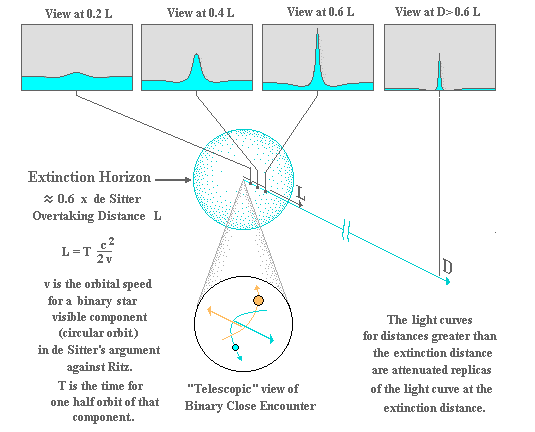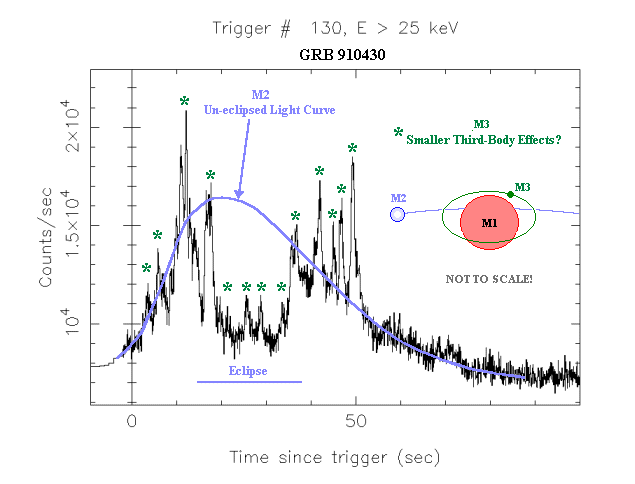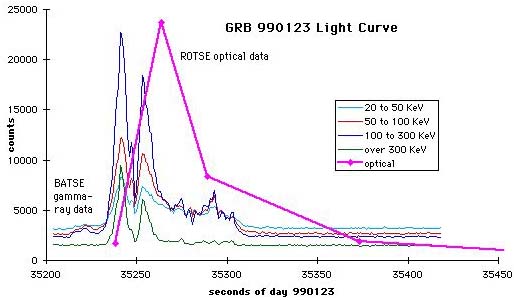This article has the following sections.
A Ritzian Interpretation of Variable Stars
Non-pulsating Cepheid Variables
Ritzian Gamma-Ray Bursts
Ultra High Energy Cosmic Rays
Modeling Geminga
Unsung Binaries and de Sitter's Whimsical Images?
GRB 790731 and omega Geminorum
Ritzian Gamma-Ray Bursts
(Alternate title: Stellar Gamma-ray Flashes)
A continuation ofA Ritzian Interpretation of Variable Stars.
Renamed and updated on 17 Dec 2003. Latest revision (Broken URL links identified] - 01 Apr 2019.
Latest changes or additions are in bold.
Key words: Gamma-ray Flash, Gamma-Ray Burst, stellar encounters, relativity tests.
If memory serves correctly, of the first 24 detections of Gamma-Ray Bursts (GRBs), for which approximate directions to them could be established, 20 were daytime events. (It might have been 16 out of 20.) [Looking for misplaced reference.] (A daytime event, as used here, means that the angle between the line joining the center-of-the-Earth and the Sun, and the line from the center-of-the-earth in the direction of a given GRB, is 90 degrees or less.) 83 percent of the detections were day-time events. The purpose of the Vela satellites was to monitor worldwide compliance with the 1963 nuclear test ban treaty. One doesn't conduct secret atmospheric or outer-space nuclear tests at night, so, in the author's opinion, the preponderance of daytime GRB detections was suggestive of an experimental bias, i.e., we were looking most intently in the daytime. Could it be that explosions were being sought, and explosions are what were found? See: J. Bonnell's A Brief History of the Discovery of Cosmic Gamma-Ray Bursts.
One alternative (non-explosive) interpretation of GRBs is that they are extrinsically produced by Ritzian c+v relativity effects, associated with close encounters of normal, dwarf, and/or neutron stars. (This is, of course, contrary to Einstein's Special Theory of Relativity.) According to Ritzian relativity, the element of variability for GRBs is information arrival time. GRBs could turn out to be apparent time-modulation phenomenon. The stars involved in the production of Ritzian GRBs could be located nearby, in the disk structure of the Milky Way. [Abstract was extensively reworked in the 15-18 Jan 2004 timeframe.]
Using John Fox's extinction-limited version of Ritzian Electrodynamic Theory, the phenomena commonly called gamma-ray bursts (GRBs) can be interpreted as the result of information arrival time squeezing for close encounters of non-intrinsically variable stars. The flash for a given star (at locations remote from the center-of-mass of the interacting bodies) should be in a fan-shaped zone (That's not stated correctly. See note below.*), which is oriented perpendicular to the component's plane of motion, and on the opposite side from perihelion. The flashes are not intrinsic to either (or any) of the stars involved. (In the local vicinity of the interacting stars [where the minimum separation between the stars is an appreciable fraction of the system-to-observer distance] there will be no flash or burst observed.) See the basic article for a description of the physical process being discussed. Where the stellar paths involved are highly elliptical orbits, Ritzian relativity can be used to explain repeating gamma-ray flashes or soft gamma repeaters (SGRs).
*Energy from any given GRB is not concentrated (or re-directed) in an angular sense. Ritzian GRBs result from time-wise concentrations of energy that would have reached a given point in any case.
Possible evidence for the hypothetical fan shaped zone, viewed from the side, may be seen in the Astronomy Picture of the Day for May 14, 2002, N44C: A Nebular Mystery. The accompanying text states, "One hypothesis is that the known central star has a neutron star companion in a very wide orbit. Hot X-rays might only then be emitted during brief periods when the neutron star nears the known star and crashes through a disk of surrounding gas." (The Ritzian hypothesis wouldn't require the crashing.)
Fox attributed the extinction process, described as follows, to Richard Tolman(1), however Tolman dealt strictly with the abrupt change in speed of light upon its reflection from a mirror. -- Electrical charges in an environment absorb and re-radiate electrodynamic information (presumably by Rayleigh scattering) in a manner that leads to the extinction of the original information and to its replacement with a replica which travels at the speed of light c (in vacuum) with respect to the re-emission sources in that environment. If the original information happened to be traveling at a speed different from the "local"c, the replica will, so to speak, have the difference stripped off.
Ritzian Gamma-Ray Bursts, as defined here, would constitute one phenomenological niche in the ever growing menagerie of variable stars. This article is an outgrowth of a way of thinking about variable stars, in general, posed by Vladimir Sekerin(2) in 1987.
The (remote) arrival-time information-compressions that accompany perihelion passages can produce short duration spikes of extremely high energies where the ... extinction distance is on the order of 0.5 to 0.7 times the Ritz/de Sitter c+v overtaking distance. (The extinction phenomenon fixes or freezes the c+v effects for distances greater than that for extinction.)
The following graph shows a close encounter of two stars which could lead to gamma ray flashes. Light curves for the blue component are shown for increasing distances from the encounter. For this example an ... extinction distance equal to 0.6 times the de Sitter overtaking distance is used. (For simplification we will specify that extinction occurs at the stated distance.)

References to Tolman have been removed from the drawing.
The spectral intensity peak of an otherwise conventional star or white dwarf can be chirped (a rapid upshift - followed by a rapid downshift) from the visible or ultraviolet regimes to the X-ray or Gamma-ray regimes, and back. This is intended to explain the paucity of optical counterparts for the majority of Gamma-ray flashes/bursts. Spectral analysis of Gamma-ray burst after-glows are predicted to reveal blueshifted conventional stellar absorption and emission lines which are sliding back downward toward their normal spectral habitats. (By the time these are captured most of the down-sliding will have already taken place.)
Since binary star close encounters are hypothesized here, we should expect to occasionally see evidence of eclipses which block out portions of the burst/flash light curves. Some of these will occur in such a manner that a given burst will start, (creating the precursor) then be blanked by the eclipse, (the eclipsing star being of larger diameter than the burst source), followed by an extremely short rise-time to near peak activity (source pops back into view), followed by a normal peak and subsequent decay to the afterglow region. (Other eclipse effects, such as dips in the peaks should be expected too.) These kinds of things are in fact observed.
The following marked up BATSE graph(3) for GRB 910430 demonstrates hypothetical effects of a three body interaction, where M1, the primary, has a radius on the order of 2 -10 times that of M2. The far side passage of M2 (behind M1) provides the main part of the burst. A third body M3, is posited to be orbiting M1 in such a manner that its far side swings around M1 produce the thirteen-or-so fine-structure peaks, (marked with green asterisks on the graph). [Note that they continue, unabated, during the central lull of the main burst.] (The gravitational effect of M2 on M3 would be to perturb its orbit with respect to M1.)

The abrupt cessation of the fine-structure spikes (the suggested M3 effect) can be
interpreted as M3 having being flung out of orbit from around M1, or crashing
into either M1 or M2. [The preceding two paragraphs and graph have been modified based
on results obtained during computer modeling during June and July of 2004.]
The article "A Strange Supernova with a Gamma-Ray Burst indicates a possible link between a Gamma-ray burst and the supernova SN 1998bw." [Was at http://www.eso.org/outreach/press-rel/pr-1998/pr-15-98.html]. According to the Ritzian hypothesis, the GRB could be the tip of the iceberg, so to speak, of the supernova. Emission and/or absorption lines for the fading SN 1998bw supernova should be checked to see whether or not they are sliding downward in frequency toward an unperturbed stellar spectrum.
For another event of this nature see: Gamma-Ray Burst Afterglow: Supernova Connection Astronomy Picture of the day, 5 April 2002.
See also: "Astronomers link X-ray flashes to gamma-ray bursts." [Was at: http://www.lanl.gov/worldview/news/releases/archive/02-038.shtml.] These findings are very consistent with the Ritzian relativity model. That is, stars that are brightest in visible light can have their spectra time-squeezed briefly up into the UV and X-ray region. Stars brightest in UV and X-rays can have their spectra briefly squeezed upward into the Gamma ray region. There should be lots of room for spectral regime overlaps.
One might ask: What, in this case, is the difference between a burst and a flash? Could it turn
out that Gamma-ray Bursts are really Gamma-ray Flashes? What is there about GRBs that leads
incontrovertibly to the conclusion that explosions are involved? Is there anything
about the time-evolution of their spectra that points away from the idea of explosions?
(The delayed humps in afterglows might turn out to be Ritzian signatures of the
other star involved in a two-star encounter.) For a possible example, see:
X-ray afterglow observations of Gamma-Ray Bursts with Chandra and ASCA (Iron line diagnosis
in X-ray afterglows) [An expected iron K alpha line couldn't be found.]
Closed elliptical orbits of close binaries should produce repeating flashes such as the object now known as the Geminga soft gamma repeater. About 12 Gamma-ray repeaters have now been documented. (As of April 1999) See the Transient Outburst Summary in the BATSE Bright Source Monitor (Pulsed Sources) article. [Was at http://www.batse.msfc.nasa.gov/batse/pulsar/data/histories.html.]
See Modeling the Geminga Gamma-Ray Pulsar and A Possible Connection between KONUS 790731 and Omega Geminorum.
In principle, any close encounter of two stellar objects (or of a star and, say, a Jupiter sized object) could produce a pulse or burst of light in the sense mentioned above. Even comets, (reflected light in their case) at perihelion passage, should not be ruled out as potential sources of flashes.
The extinction theorem predicts that higher frequencies have longer extinction lengths than lower frequencies. If this is true, then the Ritz-de Sitter hypothesis would predict situations where a binary with a single visible component might present itself as a single broad low-amplitude pulse at radio frequencies, (extinction distance less than Lo); as a sharp high-amplitude pulse at optical frequencies (extinction distance approximately equal to Lo) and as a double pulse (sharp exterior rise and fall times with an interior "saddle shaped" emission bridge ) in X-ray or Gamma-ray regimes (extinction length greater than Lo). [This paragraph may be biting off more than should be chewed. It may end up being deleted or seriously modified. RSF - 24 April 2002.]
Kenneth Brecher gave a talk on testing special relativity using Gamma Ray bursts at the April 2000 APS meeting in Long Beach California. He evaluated the expression c' = c + kv where k = 0 for special relativity and k = 1 for the Ritz ballistic hypothesis. He states "If the SR second postulate is invalid, photons emitted simultaneously towards an observer from a source at distance L, characterized by internal velocities v (both towards and away from the observer), will arrive at the observer as a pulse of finite width dt, implying a value of k = (c^2/2v)(dt/L)." He used v > 0.1c, dt = 1.0 msec and a cosmological distance of 10^28 cm for L (GRB to observer). For these values we get k = 10^-20. Brecher says "This represents, by a factor of 10^9, the most precise test of the second postulate of special relativity to date."
According to John Fox(4), ... source-to-extinction distance has to be used in calculations, such as in Brecher's special relativity test, rather than the source-to-observer distance. (For cosmological distances the former is generally very much shorter than the latter.) When we plug in the extinction distance, as estimated from the Crab pulsar light curve (see the main article) L=0.93*10^10cm, (which is approximately one fourth of the Earth-Moon distance) we arrive at a much fuzzier result for this SR test, i.e., k=1.6*10^-2.

The author has not checked on this yet, but if one or more GRBs become detected within the (line-of-sight) angular confines of, say, the Coal Sack or some other extended opaque dusty region in our galaxy then it would seem presumable that the source(s) of those gamma rays will be between us and the dust cloud.
With regard to the redshift information that seems to place GRBs at extreme distances, readers are enjoined to look over a rather sophomoric but sincere essay on an alternate take on redshift. See Cosmological Redshift.
See: 'Local' gamma ray bursts may solve a mystery or two" NASA-GSFC News Release, Posted Jan 22, 2002.
A section on cosmic ray showers, which was added here on 7 February 2002 and revised 24 April 2002, has been relocated (on 1 February 2003) to a new page called Ultrahigh-Energy Cosmic Rays.)
(Added 22 April 2002)
A scan for "gamma ray bursts" at the arXiv.org
website led to a 22 February 2000 abstract by Charles Dermer and Markus
Boettcher, titled
Flash-Heating of Circumstellar Clouds by Gamma Ray Bursts. The search
for such a phenomenon might be considered as an experimentum crucis
for the Ritzian hypothesis versus the standard model.
(Added 24 April 2002.)
The ScienceNow article Fierce Flash, Strange Star summarizes a paper in the 9 July 2001 edition of Physical Review Letters (reference to follow) which describes two mysteriously bright gamma ray flashes, whose blasts failed to shred the source neutron stars. Based on these failures, it has been hypothesized that maybe the two objects involved were quark stars, which are thought to be much better glued together than neutron stars. The Ritzian interpretation of the events could be that no explosions occurred, and therefore no mystery. The word could is used here on purpose. Before Ritz can be cheered, it will be necessary to determine if binary encounters of some sort were involved in both flashes.
There is a report, on page 246 of the 20 April 2002 issue of Science News, which deals with NASA evidence which may further point to the possibility of strange stars with novel forms of matter. Pros and cons of the idea are discussed. In one case, a revised distance measurement to one of the stars in question is said to remove support for "an extremely soft equation of state." An abstract for the paper dealing with this latter claim can be found at arXiv.
Here are light curves for GRB 990123. According to NASA (See: Autopsy of an Explosion.) This was the first gamma-ray burst for which a concurrent prompt visible light curve was recorded.

GRB 990123 light curves from the Robotic Optical Transient Experiment
(ROTSE, purple) and the Burst And Transient Source Experiment (BATSE)
Image from NASA/Goddard Space Flight Center
Note that the BATSE light curves are double peaked, whereas the ROTSE light curve seems to be single peaked. If the optical light curve is actually single peaked, then it could be considered as evidence in favor of Ritz's ballistic theory of light(6) as modified by Fox's extinction theorem(4). (Gamma-rays would have longer extinction lengths than visible light. The longer extinction lengths would allow Ritz's C+V effects to operate over a greater distance and produce the double peaks, whereas the shorter extinction length for visible light would tend to cut the process off at the single peak phase.) A word of caution. The time intervals between data points for the ROTSE curve do not permit the same time-wise resolution as those for the BATSE. [Added 09 Mar 2006.]
Recommended reading
Astronomers link X-ray
flashes to gamma-ray bursts Los Alamos National Laboratory News Release - 24 April 2002 - SpaceFlight Now.
Evidence for the Galactic Origin of Gamma-Ray Bursts - B. M. Belli - Istituto di Astrofisica Spaziale, CNR, Italy.
See GRB 990510 and a Solar Wind Problem to review a hypothetical space weather interaction of a GRB with the solar wind. [Link was changed on 17 August 2003.}
References
(1) R. Tolman, Phys. Rev. 31>, 26 (1910); ibid. 35, 136 (1912).(2) V.I. Sekerin, Contemporary Science and Regularity in its Development, 4, 119-123, (1987) Tomsk University (In Russian.). For an English translation, see http//www.datasync.com../sekerin.htm.
(3) Compton Observatory BATSE Second Burst Catalog, Compact Disc, Disk 1, USA_NASA_COSSC_BATSE_0002.
(4) J.G. Fox, Am. J. Phys. 33, 1, 1965.
(5) E. Waxman, Phys. Rev. Lett., 75, 386 (1995); M. Milgrom and V. Usov, Ap. J., 449, L37 (1995).
(6) W. Ritz, Annales de Chimie et de Physique, 13, 145 (1908). See English translation at: Critical Researches on General Electrodynamics.